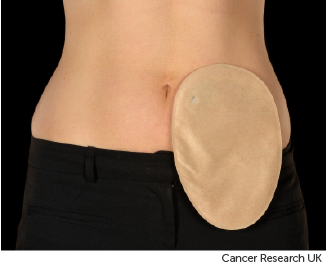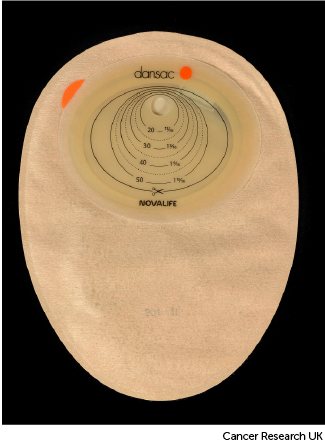Having a colostomy for bowel cancer
A colostomy is an operation to create an opening (stoma) of the large bowel (colon) onto the surface of the tummy (abdomen).
Your poo no longer passes out of your body through your back passage. Instead it passes out through the stoma. You wear a bag stuck onto the skin over the stoma to collect your poo.
Why you might have a colostomy
You might have a temporary colostomy with surgery to remove part of the colon. This is to give your colon time to rest and heal after surgery. Your surgeon joins the ends of the colon back together in another operation. This is called a stoma reversal. Your surgeon will tell you when you are likely to have this operation.
You might need a permanent colostomy if your surgeon has to remove a large part of your colon and can’t join the remaining ends of colon together. Your surgeon will avoid this if at all possible.
What a colostomy looks like
The opening on your abdominal wall (stoma) will be round or oval. It looks red and moist like the inside of your mouth. It doesn't hurt because it has no nerve supply. Because of this you must be careful not to injure your stoma because you won't be able to feel if you have done any damage.
The stoma will be swollen just after your operation but it will get smaller and flatter.

These photographs show one type of colostomy bag from the front and back.


The stoma nurse
Stoma nurses are experienced in looking after stomas (ileostomies and colostomies) and teaching you how to look after them. A specialist nurse will visit you on the ward to show you what to do.
The stoma nurse will see you on the day of the operation. They use a pen to mark where a stoma might be created. For the first few days after your operation the stoma nurse will help you look after and clean the stoma, and change the bags. This is called stoma education. They will also help you to find which type of stoma bag is the best for you.
Your stoma nurse will give you stoma bags to take home. You get more from the chemist or a local stockist. Supplies are free, but you need a prescription from your GP.
Looking after your stoma
Learning to look after a stoma takes time and it can be worrying at first. But you won't be expected to cope on your own. You will find that it gets easier with time.
It is helpful to keep everything you need to change your stoma bag together in one place. That way, you won't be half way through and realise that something vital is missing.
Going home with a colostomy
Talk to your stoma nurse or ward nurses about the kind of support you will need at home. Before you leave hospital you might want the stoma nurse to show your relatives how to look after the colostomy. They can help when you get home.
Your stoma nurse will give you a contact number before you leave the hospital. You can ring them for advice and support, and the nurse may arrange to visit you at home. Or a district nurse may visit for a few days to make sure you are coping.



